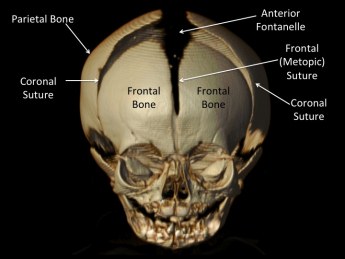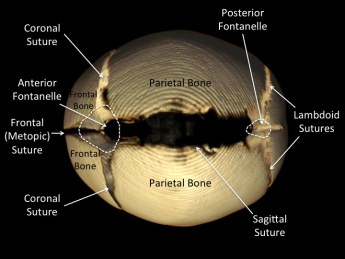Dallas
214-456-2240
Fax: 214-456-8881
Plano
469-497-2501
Fax: 469-497-2507
Request an Appointment with codes: Plastics and Craniofacial Surgery
214-456-2240
Fax: 214-456-8881
469-497-2501
Fax: 469-497-2507
Request an Appointment with codes: Plastics and Craniofacial Surgery
(crane-eo-sin-oh-STOW-sis)
The skull is formed by several separate bones. These skull bones are connected to one another by specialized structures called sutures. These sutures look like seams or spaces between the skull bones. The sutures are growth centers for the skull bones. Craniosynostosis is present when one or more of the sutures closes earlier than it should causing the skull to grow into an abnormal shape.




Babies' brains grow very quickly in the first two years of life. As the brain grows it stretches the sutures which signals the sutures to make new bone. The sutures allow the skull to enlarge and create just enough space for the brain. Normally, these sutures remain open until we reach adulthood, long after the brain and skull have stopped growing. Craniosynostosis causes a baby’s skull to be misshapen because the brain continues to grow at the same rate even if one or more sutures closes too early.

The remaining open sutures have to grow faster to make up for the closed suture. This extra growth causes a change in head shape. In some cases, the remaining open sutures can’t grow fast enough to keep up with the brain’s growth causing an abnormally high pressure in the skull, which can have negative effects on brain health. These include learning delays, blindness, and, rarely, death, if untreated.
Meet some of the patients we have treated to become familiar with what you can expect if your child is affected with craniosynostosis.
See craniosynostosis before and after photos
Craniosynostosis can affect babies in two different ways. The needs and expected courses of treatment for these two groups of patients are different and are discussed separately.
Isolated craniosynostosis, also known as non-syndromic craniosynostosis, is the closing of only one suture with no other associated health problems and is the most common kind of craniosynostosis.
Syndromes are when three or more medical problems occur in a recognizable pattern. When craniosynostosis is part of a syndrome, it is known as syndromic craniosynostosis. In these cases, there are usually two or more sutures that closed too early. Patients also have other health conditions as part of the syndrome.
A Strip Craniectomy (Suturectomy) is a surgical procedure where doctors open the scalp to expose closed cranial sutures. Doctors then cut out these sutures to allow the brain to expand and push the skull bones out.


Craniosynostosis is not the most common cause of an abnormal head shape. The most common cause by far is called positional or deformational plagiocephaly (play-GEE-oh-sef-alee).
A baby’s skull has 6 major cranial sutures:
The baby’s growing brain is what makes their skull grow. The growing brain does this by mechanically triggering growth signals in the sutures that leads to new bone formation and enlargement of the skull bones. This keeps the skull just large enough for the brain to fit perfectly. The brain more than triples in size during a child’s first 2 years of life. To make room for the brain, the skull must grow rapidly during this time, reaching 80% of its adult size by the age of 2 years. By age 5, the skull has grown to over 90% of the adult size. All sutures remain open until adulthood, except for the metopic suture which usually closes between 6 and 12 months of age.
A baby will have a misshapen head when one or more of the sutures closes too early. This usually happens prenatally, before the child is born. Again, the brain is growing very quickly at this age. The remaining open sutures must grow faster to create the space inside the skull that the closed suture was supposed to accommodate. This extra growth at the open sutures causes a misshapen head. The abnormal head shape created by craniosynostosis depends on which sutures are closed. Craniofacial surgeons can usually determine which suture(s) is closed when they examine the patient because the abnormal head shape that the closure of each suture produces is characteristic. In about 15 out of 100 cases, one closed suture results in the skull not growing fast enough to keep up with the rapid growth of the brain. This can be harmful to the health of the brain. The more closed sutures there are, the higher the likelihood that the skull will not be able to grow fast enough.